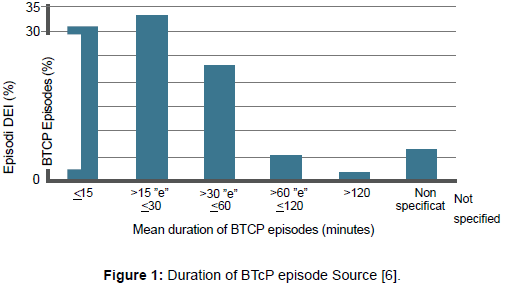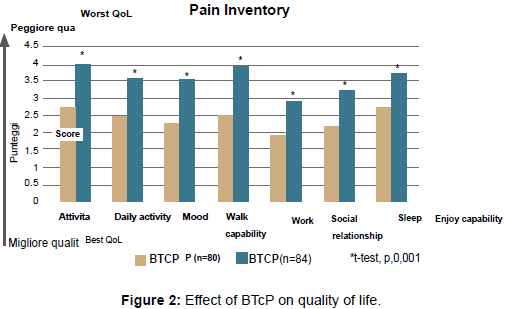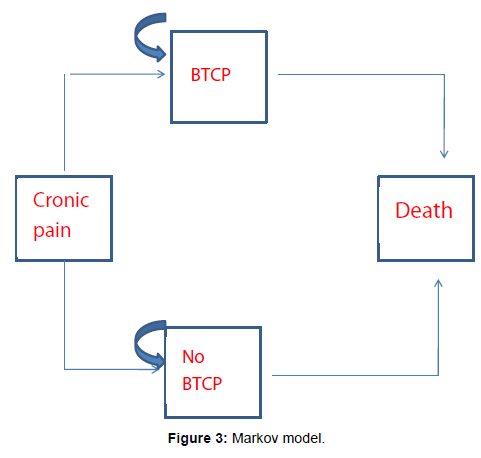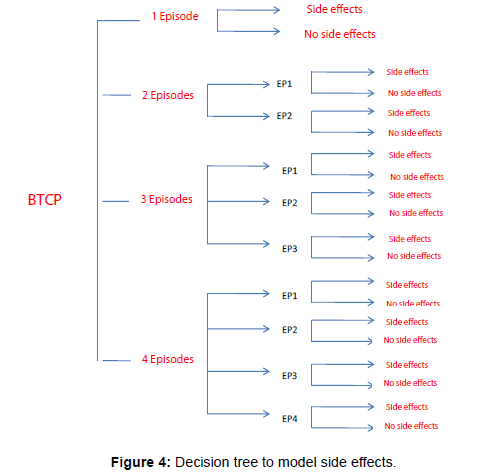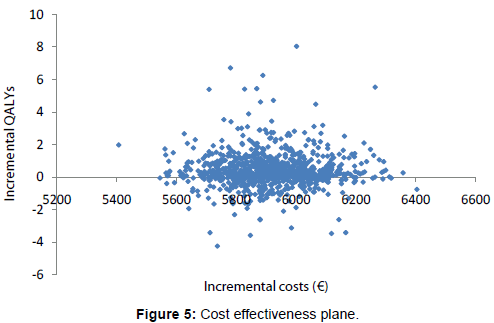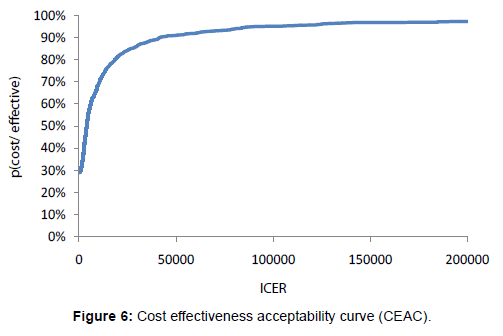Research Article Open Access
Cost Effectiveness Analysis of Instanyl for the Treatment of Breakthrough Cancer Pain (BtcP)
Ruggeri M1*, Oradei M2, Turriziani A3 and Cicchetti A11Faculty of Economics, Università Cattolica del Sacro Cuore, Rome, Italy
2Technology Assessment Unit, Policlinico Universitario “A.Gemelli”, Università Cattolica del Sacro Cuore, Rome, Italy
3School of Medicine, Università Cattolica del Sacro Cuore, Rome, Italy
- *Corresponding Author:
- Ruggeri M
Faculty of Economics
Università Cattolica del Sacro Cuore
Rome, Italy
E-mail: mruggeri@rm.unicatt.it
Received date February 12, 2013; Accepted date February 26, 2013; Published date March 01, 2013
Citation: Ruggeri M, Oradei M, Turriziani A, Cicchetti A (2013) Cost Effectiveness Analysis of Instanyl for the Treatment of Breakthrough Cancer Pain (BtcP). J Palliative Care Med 3:141. doi:10.4172/2165-7386.1000141
Copyright: © 2013 Ruggeri M, et al. This is an open-access article distributed under the terms of the Creative Commons Attribution License, which permits unrestricted use, distribution, and reproduction in any medium, provided the original author and source are credited.
Visit for more related articles at Journal of Palliative Care & Medicine
Keywords
Cancer; Instanyl; Opioids
Introduction
Cancer is a disease that is very widespread in every country in the world, especially in industrialized countries. In Italy there are an estimated 300,000 new cases of cancer/year, with an estimated mortality of around 160,000 and a prevalence of around 3% [1,2]. The most common symptom of cancer patients is pain, which is categorized in two forms: background pain (baseline pain or persistent pain) to be treated with fixed doses of analgesic treatment at pre-determined times, and intense episodic or Breakthrough Cancer Pain (BTcP), which needs drug treatment on demand. BTcP is a transitory exacerbation of the intensity of the pain in a patient with background pain that is well controlled by analgesic treatment (with morphine) administered continuously [3]. Background pain, which lasts for 12 hours or more, is distinguished from BTcP, which is characterized by short duration, rapid onset and severe intensity. The duration and intensity of BTcP have been studied by several authors.
According to Zeppetella and Ribeiro [4] the mean duration is 30 minutes, and less than one hour in 90% of episodes [3,5]. Similar results were presented from a study carried out by Gomez-Batiste et al. [6] in which the mean duration was 33.8 minutes with 87% of the episodes of less than 60 minutes’ duration, and 31% resolved after 15 minutes (Figure 1). While for intensity, the study carried out by Portenoy et al. [7] reported that maximum intensity was reached within 3 minutes of onset. The pain event may be caused by the primitive neoplastic lesion, bone metastases, chemotherapy, radiotherapy, peripheral nerve or medullary compression, abdominal colic, oral mucous membrane lesions (triggered by swallowing or chewing), skin lesions, or muscle spasm. Pain presents a considerable impact on the quality of life of cancer patients, since it limits the patient’s movement and capacity to conduct a normal life (Figure 2), and has effects that are not only physical but also psychological, with a significant increase in levels of depression and anxiety [7] and healthcare system resources. In particular, there is greater recourse to specialist and non-specialist medical consultations, hospitalization and prolonged hospital stays [8]. The study carried out by Fortner et al. [9] reports the cost per patient with BTcP is $ 12,000/ year compared to $ 2,400/year for patients who do not present BTcP. The drugs most widely used to treat individual episodes of BTcP are the opioids. The choice of administration route is an important criterion in the decision to treat BTcP, since it influences the time at which the analgesic action appears [4]. The first routes used to administer drugs were oral (e.g. morphine), but this mode of administration proved too slow, and not capable of decreasing the development of intense pain in a short period of time. Other administration routes, such as intravenous and subcutaneous have displayed the same limitation as oral administration, apart from transmucosal administration, which permits fast absorption and hence the rapid appearance of analgesic action [10]. To overcome this limitation researchers have focused on new drugs that can act rapidly on the pain. The appearance of fentanyl (e.g. Actiq) on the market was a step forward: this permits faster speed of action than traditional drugs, although it is still too slow to be able to guarantee immediate relief of pain in the patients treated. Better results were obtained with Instanyl. Intranasal administration guarantees greater benefits for the patient compared to other drugs, since it presents a shorter mean duration of action than Actiq: 56 minutes compared to 2 hours, which follows the time trend of BTcP (30 minutes) better. It also permits a lower risk of deglutition, and the consequent passage into the alimentary tract, guaranteeing better capacity of absorption of the active substance. So far, while several studies have proven the effectiveness of Istanyl, limited evidence is actually available on the economic affordability for a third party payer (i.e. National Healthcare Systems). As long as the treatment is available for advanced cancer patients, with a limited life expectancy, one could argue about the “opportunity cost” of allocating resources to these patients instead of others with probably higher chances of living longer. The question is even more challenging when the decision maker is a private insurer. The only way to address this question is to perform a cost effectiveness analysis, whose aim is to estimate the cost per Quality Adjusted Life Year (QALYs) of Istanyl compared to the use of morphine. In this paper we present the results of this analysis.
Methods
Structure of the analysis
The analysis was carried out by constructing a Markov model that simulates the natural history of a hypothetical cohort of 100 advanced cancer patients: the patients in the case arm of the study are treated with Instanyl, and those in the control arm with morphine. Consistently with the Instanyl treatment indications, the hypothesis was that patients would have a minimum of 1 to a maximum of 4 episodes of BTcP per day, and that administration of Instanyl might cause side effects which influence both cost and Quality Of Life (QoL) (Figures 3 and 4). The natural history lasted 7 years, the maximum time in which, all the patients would die [1,2], considering the average mortality of an advanced cancer patient.
The probabilities of having BTcP were taken from the literature as well as the mortality rates for cancer patients. Table 1 shows the prevalence of BTcP in the data reported in the literature from 1990 to 2003 [4], which show great variability (20-93%). This is due to the different patient sampling methods and the absence of tools that can diagnose pain in cancer patients. Considering the mean prevalence reported in the studies below, we estimated a probability for oncologic patients of 56.3% of having BTcP (Figure 3).
| Author | Year | Prevalence | Author | Year | Prevalence |
|---|---|---|---|---|---|
| Portenoy | 1990 | 65% | Caraceni | 1999 | 65% |
| Banning | 1991 | 93% | Portenoy | 1999 | 51% |
| Bruera | 1992 | 20% | Zeppetella | 2000 | 59% |
| Mercadante | 1992 | 31% | Swarwick | 2001 | 93% |
| Ashby | 1992 | 35% | Natal | 2001 | 60% |
| Grond | 1996 | 59% | Fortner | 2002 | 63% |
| Fine | 1998 | 56% | Gomez-Batiste | 2002 | 41% |
| Petzke | 1999 | 40% | Hwang | 2003 | 70% |
Table 1: Prevalence of BTP: evidence from studies.
Effectiveness data
To include the effectiveness of Instanyl in our model, we selected three clinical studies from the literature. Two of these studies compare Instanyl with placebo, while the third compares Instanyl with Actiq. The studies show that Instanyl is more effective, compared to both placebo and Actiq, thanks to the increased speed of its analgesic activity, and hence to its more rapid pain relief (a reduction of 31.25% in the time taken to achieve the analgesic effect) [11-13].
Cost data
Based on the data in the literature, we populated our model considering the probability of the daily frequency of episodes of BTcP and the associated probability of side effects reported in the literature [3]. Regarding the probability of having 1 to 4 episodes per day, we considered the following probabilities:
- 1 or 2 episodes 20%;
- 3 episodes: 50%;
- 4 or more episodes 10%.
Each of these episodes was associated a cost of 5.87 euros when treated with Istanyl and a cost of 2 euros per day when treated with morphine.
Consistently with the administration of Istanyl, we estimated a probability of having side effects (nausea, vomiting, asthaenia, diarrhoea, constipation) of 3% [3-4,13]. These side effects were treated with Plasil © (expert opinion), at a daily cost of 1 euro. Finally, table 1 reports the hospitalizations, days of hospital stay, visits and emergency visits considered by Fortner et al. [9] which were used to estimate the costs to the Italian national health service perspective. Hospitalizations were given a cost of euro 700, by referring to the oncology DRG (Diagnosis Related Groups) tariffs and the mean cost of a day of hospitalization reported by the Italian Ministry of Health [14]. The mean cost of Emergency access [15] was estimated 125 euros, and the cost of a medical consultation as reported by the Italian tariff for outpatient services [16] as 20.66 euros.
Quality of Life (QoL)
Quality of life weights were used to differentiate the health status associated to BTcP depending on whether Instanyl © or placebo was used. Using the data in the literature [3,5,7,11,17] and expert opinion, we associated to patients treated with morphine a QoL value of 0.001 and to patients treated with Istanyl a QoL value of 0.46.
Presentation of results and sensitivity analysis
The results were expressed in the form of Incremental Cost Effectiveness Ratio (ICER): the difference between the costs of Instanyl (considering side effects) and the costs placebo were related to the difference in Quality Adjusted Life Years (QALYs) between Istanyl and morphine. Probabilistic sensitivity analysis was conducted to assess the variability of results associated to the variation of costs, side effects episodes, daily BTcP episodes and BTcP prevalence. This analysis returned a set of different ICERs which were plotted into a cost effectiveness plane and a Cost Effectiveness Acceptability Curve (CEAC) to show the probability of Istanyl to cost less of 30,000 euros/ QALY.
Results
Table 2 shows the results of our analysis. The treatment of BTcP with Instanyl costs 8,893 euros with an outcome of 0.63 QALYs, whilst the treatment with morphine costs of 6,431 euros for a QALY of 0.29. These data generate an ICER of 10,140 euros/QALY (Table 3).
| Events | Patients with BTcP (n=160) | Patients without BTcP (n=89) |
|---|---|---|
| Mean hospitalizations/year | 1 | 0.4 |
| Mean stay in hospital (days) | 7.1 | 4.1 |
| Mean emergency department visits/year | 1.3 | 0.5 |
| Mean doctor visits/year | 4.2 | 0.6 |
Table 2: Healthcare resource cost drivers [9].
| Instanyl | Placebo | INCR COST | INCR QALY | ICER | |
|---|---|---|---|---|---|
| Costs | € 9,893 | € 6,431 | € 3,461 | 0.34 | € 10,140 |
| QALY | 0.63 | 0.29 |
Table 3: ICER.
Sensitivity analysis
The sensitivity analysis shows as changing the number of side effects, visits, hospitalizations, BTcP prevalence and episodes, the ICER can increase of 30% or decrease of 40% (Figure 5). For example, in the case of 2 BTcP episodes per day, the ICER would be 5,764 euros/ QALY, while in the case of 4 episodes per day the ICER would rise to 17,190 euros/QALY. Overall, the Cost Effectiveness Acceptability Curve shows that the treatment of BTcP with Instanyl would have an 86% probability of having a cost lower of 30,000 euro/QALY (Figure 6).
Discussion
In this article we have carried out cost effectiveness analysis of the treatment with Instanyl for Breakthrough Cancer Pain (BTcP), in comparison with the administration of morphine. The results clearly show that Istanyl administration is a good and sustainable investment in health, despite the collateral effects and the short life expectancy of advanced cancer patients. The principal motivation is the gain on quality of life, given the extreme severity of the disease. BTcP is in fact a manifestation of cancer that worsens the patient’s perception of the disease, in a clinical situation that is already heavily compromised.
Instanyl, as the principal effectiveness findings show, is an appropriate therapeutic option for the clinical management of BTcP. Intranasal administration is not invasive, results in high bioavailability without the first passage effect, and is well accepted, because it is easy for most patients to manage. In addition, Instanyl can be also used in the same way by patients with xerostomia, nausea and oral mucositis, unlike oral transmucosal formulations.
As a result, Instanyl constitutes an effective treatment innovation, given its documented pharmacokinetic profile and clinical efficacy.
The favorable cost-effectiveness ratio supports the sustainability of Instanyl in economic terms too. The results of the economic assessment are in line with a similar recent study, in Sweden, which reported an ICER of 12,203 euros/QALY. However, it should be noted that this study compared Instanyl with alternative treatments in terms of administration route (transmucal and oral) [18]. The study has strength and weakness which need to be pointed out. Firstly, the work was carried out based on a hypothetical cohort of patients to whom the cost data and evidence of efficacy results of the related trials were applied. While this allows projection of the results in time, and generalisability of the results, it does not represent real data, which would require the design of an ad hoc study to collect real cost data. Secondly, the model considers generic cancer patients, and does not consider the various diseases in the area of oncology. Regarding this, it must be stated that there is as yet no specific information on different efficacy for various diseases, nor is there even the possibility of differentiating. However, the accuracy of the sensitivity analysis carried out lead us to assume that the different scenarios represented different oncologic disease, although they are not specifically identified. A similar consideration may be made regarding the level of severity and the staging of the cancer. Thirdly, the study considers quality of life ratings for an Italian population for the first time and the algorithm for this population is still in the external validation phase, at present. If on the one hand the use of as yet unpublished coefficients may be considered a distortion factor, on the other, they provide more conservative results than the coefficients that are officially used, relating to a British population. In support of this, it is enough to consider that the episodes of BTcP without Instanyl administration correspond to a British population QoL coefficient that is negative (worse than death) while the corresponding value in the case of the weights used in the study at that health status is just above 0. Moreover, the QoL coefficients that summarise the health status are based on the expert opinions and assume changes only in the perceptions of pain (from moderate to severe). In reality, even worse health states could have been hypothesised, given that, again according to the expert opinions, the BTcP patients also experiences a negative impact on mobility, anxiety and daily activities. In this case too, the choice of maintaining a difference between BTcP with and without the administration of Instanyl based solely on pain is prompted by the desire to present conservative results, with a sensitivity analysis that also includes scenarios that are different but increasingly favourable to the treatment considered in this economic assessment.
References
- Negri E, La Vecchia C, Decarli A (2002) Cancer mortality in Italy, 1998. Tumori 88: 89-94.
- Micheli A, Mugno E, Krogh V, Quinn MJ, Coleman M, et al. (2002) Cancer prevalence in European registry areas. Ann Oncol 13: 840-865.
- Portenoy RK, Hagen NA (1990) Breakthrough pain: definition, prevalence and characteristics. Pain 41: 273-281.
- Zeppetella G, Ribeiro MD (2003) Pharmacotherapy of cancer-related episodic pain. Expert Opin Pharmacother 4: 493-502.
- Zeppetella G, O'Doherty CA, Collins S (2000) Prevalence and characteristics of breakthrough pain in cancer patients admitted to a hospice. J Pain Symptom Manage 20: 87-92.
- Gómez-Batiste X, Madrid F, Moreno F, Gracia A, Trelis J, et al. (2002) Breakthrough cancer pain: prevalence and characteristics in patients in Catalonia, Spain. J Pain Symptom Manage 24: 45-52.
- Portenoy RK, Payne D, Jacobsen P (1999) Breakthrough pain: characteristics and impact in patients with cancer pain. Pain 81: 129-134.
- Dale O, Hjortkjaer R, Kharasch ED (2002) Nasal administration of opioids for pain management in adults. Acta Anaesthesiol Scand 46: 759-770.
- Fortner BV, Okon TA, Ashley J, Kepler G, Chavez J, et al. (2003) The Zero Acceptance of Pain (ZAP) Quality Improvement Project: evaluation of pain severity, pain interference, global quality of life, and pain-related costs. J Pain Symptom Manage 25: 334-343.
- Song Y, Wang Y, Thakur R, Meidan VM, Michniak B (2004) Mucosal drug delivery: membranes, methodologies, and applications. Crit Rev Ther Drug Carrier Syst 21: 195-256.
- Popper L, Nolte T, Kaczmarek z, Oronska A, Kaasa S (2008) Intranasal fentanyl for relief of breakthrough pain in patients with cancer. Poster presentation at the 12th World Congress on Pain, Glasgow, Scotland, UK 17-22.
- Kress HG, Oronska A, Kaczmarek Z, Kaasa S, Colberg T (2009) Efficacy and tolerability of intranasal fentanil spray 50 to 200 µg for breakthrough pain in patients with cancer: a phase III, multinational, randomized, double-blind, placebo-controlled, crossover trial with a 10-month, open-label extension treatment period. Clin Ther 31: 1177-1191.
- Mercadante S, Radbruch L, Davies A, Poulain P, Sitte T, et al. (2009) A comparison of intranasal fentanyl spray with oral transmucosal fentanyl citrate for the treatment of breakthrough cancer pain: an open-label, randomised, crossover trial. Curr Med Res Opin 25: 2805-2815.
- Agenzia Italiana del Farmaco: http://farmaco.agenziafarmaco.it/index.php
- Ricognizione e primo aggiornamento delle tariffe massime per la remunerazione delle prestazioni sanitarie. Gazzetta Ufficiale n. 289 del 13 dicembre 2006.
- Ministero della Salute. Programmazione Sanitaria e Qualità leggi e documenti-Tariffario in euro delle prestazioni specialistiche, delle protesi e drg.
- Ruggeri M, Dibidino R, Cicchetti A La stima dei pesi della qualità di vita basati sul modello EQ-5D. I risultati di uno studio pilota condotto su una popolazione italiana. Working paper.
- Vissers DC, Lenre M, Tolley K, Jakobsson J, Sendersky V, et al. (2011) An economic evaluation of short-acting opioids for treatment of breakthrough pain in patients with cancer. Value Health 14: 274-281.
Relevant Topics
- Caregiver Support Programs
- End of Life Care
- End-of-Life Communication
- Ethics in Palliative
- Euthanasia
- Family Caregiver
- Geriatric Care
- Holistic Care
- Home Care
- Hospice Care
- Hospice Palliative Care
- Old Age Care
- Palliative Care
- Palliative Care and Euthanasia
- Palliative Care Drugs
- Palliative Care in Oncology
- Palliative Care Medications
- Palliative Care Nursing
- Palliative Medicare
- Palliative Neurology
- Palliative Oncology
- Palliative Psychology
- Palliative Sedation
- Palliative Surgery
- Palliative Treatment
- Pediatric Palliative Care
- Volunteer Palliative Care
Recommended Journals
- Journal of Cardiac and Pulmonary Rehabilitation
- Journal of Community & Public Health Nursing
- Journal of Community & Public Health Nursing
- Journal of Health Care and Prevention
- Journal of Health Care and Prevention
- Journal of Paediatric Medicine & Surgery
- Journal of Paediatric Medicine & Surgery
- Journal of Pain & Relief
- Palliative Care & Medicine
- Journal of Pain & Relief
- Journal of Pediatric Neurological Disorders
- Neonatal and Pediatric Medicine
- Neonatal and Pediatric Medicine
- Neuroscience and Psychiatry: Open Access
- OMICS Journal of Radiology
- The Psychiatrist: Clinical and Therapeutic Journal
Article Tools
Article Usage
- Total views: 14280
- [From(publication date):
April-2013 - Jul 19, 2025] - Breakdown by view type
- HTML page views : 9707
- PDF downloads : 4573

